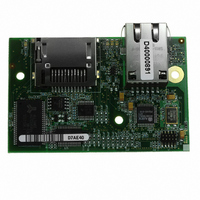20-101-1138 Rabbit Semiconductor, 20-101-1138 Datasheet - Page 20

20-101-1138
Manufacturer Part Number
20-101-1138
Description
RCM4300 RABBITCORE
Manufacturer
Rabbit Semiconductor
Datasheet
1.20-101-1139.pdf
(124 pages)
Specifications of 20-101-1138
Module/board Type
MPU Core Module
Product
Microcontroller Modules
Data Bus Width
8 bit
Core Processor
Rabbit 4000
Clock Speed
58.98 MHz
Interface Type
Ethernet
Flash
2 MBytes
Timers
10 x 8 bit
Operating Supply Voltage
3.3 V
Board Size
72 mm x 47 mm x 21 mm
For Use With/related Products
RCM4300
Lead Free Status / RoHS Status
Lead free / RoHS Compliant
Other names
316-1141
- Current page: 20 of 124
- Download datasheet (2Mb)
•
Once you have loaded and executed these five programs and have an understanding of
how Dynamic C and the RCM4300 modules interact, you can move on and try the other
sample programs, or begin building your own.
3.2.1 Tamper Detection
The tamper detection feature of the Rabbit 4000 microprocessor can be used to detect any
attempt to enter the bootstrap mode. When such an attempt is detected, the VBAT RAM
memory on the Rabbit 4000 chip is erased. The serial bootloader on RCM4300 Rab-
bitCore modules uses the bootstrap mode to load the SRAM, which erases the VBAT
RAM memory on any reset, and so it cannot be used for tamper detection. Therefore, no
tamper detection sample program is available for RCM4300 RabbitCore modules.
3.2.2 Use of microSD™ Cards
The following sample program can be found in the SAMPLES\RCM4300\SD_Flash folder.
•
RabbitCore RCM4300 User’s Manual
TOGGLESWITCH.C
using the press-and-release method of debouncing. LEDs DS2 and DS3 on the Proto-
typing Board are turned on and off when you press switches S2 and S3. S2 and S3 are
controlled by PB4 and PB5 respectively.
SDFLASH_INSPECT.c
microSD™ Card. It provides examples of both reading and writing pages or sectors to
the microSD™ Card. When the sample program starts running, it attempts to initialize
the microSD™ Card on Serial Port B. The following five commands are displayed in
the Dynamic C
The sample program prints out a single line for a page if all bytes in the page are set to
the same value. Otherwise it prints a hex/ASCII dump of the page.
This utility works with the microSD™ Card at its lowest level, and writing to pages
will likely make the microSD™ Card unreadable by a PC. For PC compatibility, you
must use the Dynamic C FAT file system module, which allows you to work with files
on the microSD™ Card in a way that they will be PC-compatible.
p — print out the contents of a specified page on the microSD™ Card
r — print out the contents of a range of pages on the microSD™ Card
c — clear (set to zero) all of the bytes in a specified page
f — sets all bytes on the specified page to the given value
t — write user-specified text to a selected page
STDIO
—demonstrates the use of costatements to detect switch presses
window if a microSD™ Card is found:
—This program is a utility for inspecting the contents of a
20
Related parts for 20-101-1138
Image
Part Number
Description
Manufacturer
Datasheet
Request
R

Part Number:
Description:
COMPUTER SGL-BRD BL2500 29.4MHZ
Manufacturer:
Rabbit Semiconductor
Datasheet:

Part Number:
Description:
COMPUTER SGL-BRD BL2500 29.4MHZ
Manufacturer:
Rabbit Semiconductor
Datasheet:

Part Number:
Description:
DISPLAY GRAPHIC 12KEY PROG OP670
Manufacturer:
Rabbit Semiconductor
Datasheet:

Part Number:
Description:
DISPLAY GRAPHIC 12KEY ETH OP6700
Manufacturer:
Rabbit Semiconductor
Datasheet:

Part Number:
Description:
COMPUTER SINGLE-BOARD BL2030
Manufacturer:
Rabbit Semiconductor

Part Number:
Description:
COMPUTER SGL-BOARD ETH BL2010
Manufacturer:
Rabbit Semiconductor

Part Number:
Description:
MODULE OP6810 W/O ETH/MEM EXPANS
Manufacturer:
Rabbit Semiconductor
Datasheet:

Part Number:
Description:
COMPUTER SINGLE-BOARD BL2020
Manufacturer:
Rabbit Semiconductor

Part Number:
Description:
COMPUTER BL2010 W/FRICTION LOCK
Manufacturer:
Rabbit Semiconductor

Part Number:
Description:
COMPUTER BL2020 W/FRICTION LOCK
Manufacturer:
Rabbit Semiconductor

Part Number:
Description:
COMPUTER SGL-BRD BL2500 44.2MHZ
Manufacturer:
Rabbit Semiconductor
Datasheet:

Part Number:
Description:
COMPUTER SGL-BOARD FULL BL2000
Manufacturer:
Rabbit Semiconductor

Part Number:
Description:
COMPUTER SINGLE-BOARD BL2110
Manufacturer:
Rabbit Semiconductor

Part Number:
Description:
COMPUTER SGL-BRD 29.4MHZ BL2610
Manufacturer:
Rabbit Semiconductor
Datasheet:

Part Number:
Description:
INTERFACE OP6800 512K FLASH&SRAM
Manufacturer:
Rabbit Semiconductor
Datasheet:










